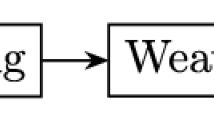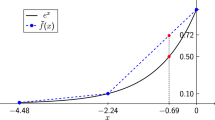Abstract
This paper introduces a novel approach for extracting the maximum number of non-overlapping test forms from a large collection of overlapping test sections assembled from a given item bank. The approach involves solving maximum set packing problems (MSPs). A branch-and-bound MSP algorithm is developed along with techniques adapted from constraint programming to estimate lower and upper bounds on the optimal MSP solution. The algorithm is general and can be applied in other applications including combinatorial auctions. The results of computer simulations and experiments with an operational item bank are presented.
Similar content being viewed by others
References
J.J. Adema, E. Boekkooi-Timminga, and W.J. van der Linden, “Achievement test construction using 0-1 linear programming,” European Journal of Operations Research, vol. 55, pp. 103–111, 1991.
E. Balas and M.W. Padberg, “Set partitioning: A survey,” SIAM Review, vol. 18, pp. 710–760, 1976.
R. Bartak, “Constraint programming: In pursuit of the holy grail,” in Proceedings of WDS’99 (invited lecture), Charles University, Prague, 1999.
E. Boekkooi-Timminga, “The construction of parallel tests from IRT-based item banks,” Journal of Educational Statistics, vol. 15, pp. 129–145, 1990.
I.M. Bomze, M. Budinich, P.M. Pardalos, and M. Pelillo, “The maximum clique problem,” in Handbook of Combinatorial Optimization (Supplement Volume A), D.-Z. Du and P.M. Pardalos (Eds.), Kluwer Academic Publishers: Boston, MA, 1999.
P.J. Brewer, “Decentralized computation procurement and computational robustness in a smart market,” Economic Theory, vol. 13, pp. 41–92, 1999.
C.G. Caplice, “An optimization based bidding process: A new framework for shipper-carrier relationships,” Thesis in the field of Transportation and Logistics Systems submitted to the Department of Civil and Environmental Engineering, School of Engineering, MIT, 1996.
S. de Vries and R. Vohra, “Combinatorial auctions: A survey,” INFORMS J. of Computing, vol. 15, pp. 284–309, 2003.
A.J. Davenport, C. An, E. Ng, G. Hohner, G. Reid, H. Soo, J.R. Kalagnanam, and J. Rich, “Combinatorial and quantity-discount procurement auctions benefit mars, incorporated and its suppliers,” Interfaces, vol. 33, pp. 23–35, 2003.
P. Fizzano and S. Swanson, “Scheduling classes on a college campus,” Computational Optimization and Applications, vol. 16, pp. 279–294, 2000.
M.R. Garey and D.S. Johnson, Computers and Intractability: A Guide to the Theory of NP-Completeness, W. H. Freeman and Company: New York, NY, 1979.
ILOG, CPLEX 8.0 User's Manual, Incline Village, NV, 2002.
I.J. Lustig and J.-F. Puget, “Program does not equal program: constraint programming and its relationship to mathematical programming,” Interfaces, vol. 31, pp. 29–53, 2001.
D.R. Musser, G.J. Derge and A. Saini, STL Tutorial and Reference Guide: C++ Programming with the Standard Template Library, 2nd edition, Addison-Wesley: Boston, MA, 2001.
G. Nemhauser and L. Wolsey, Integer and Combinatorial Optimization, John Wiley & Sons: New York, 1988.
C.H. Papadimitriou and K. Steiglitz, Combinatorial optimization: Algorithms and Complexity, Englewood Cliffs, Prentice-Hall: New Jersey, 1982.
V.T. Paschos, “A survey of approximately optimal solutions to some covering and packing problems,” ACM Computing Surveys, vol. 29, pp. 171–209, 1997.
J.-C. Régin, “Solving the maximum clique problem with constraint programming,” CPAIOR'03, http://www.crt.umontreal.ca/cpaior/, 2003.
T. Sandholm and S. Suri, “Improved algorithms for optimal winner determination in combinatorial auctions and generalizations,” in Proc. of the Seventeen Nat’l Conf. on Artificial Intelligence, pp. 90–97, 2000.
T.J.J.M. Theunissen, “Binary programming and test design,” Psychometrika, vol. 50, pp. 411–420, 1985.
W.J. van der Linden, “Optimal assembly of psychological and educational tests,” Applied Psychological Measurement, vol. 22, pp. 195–211, 1998.
W.J. van der Linden, “Optimal assembly of tests with item sets,” Applied Psychological Measurement, vol. 24, pp. 225–240, 2000.
W.J. van der Linden, B.P. Veldkamp, and L.M. Reese, “An integer programming approach to item pool design,” Applied Psychological Measurement, vol. 24, pp. 139–150, 2000.
D. Wood, “An algorithm for finding a maximum clique in a graph,” Operations Research Letters, vol. 21, pp. 211–217, 1997.
Author information
Authors and Affiliations
Corresponding author
Additional information
An erratum to this article is available at http://dx.doi.org/10.1007/s10589-006-9274-3.
Rights and permissions
About this article
Cite this article
Belov, D.I., Armstrong, R.D. A Constraint Programming Approach to Extract the Maximum Number of Non-Overlapping Test Forms. Comput Optim Applic 33, 319–332 (2006). https://doi.org/10.1007/s10589-005-3058-z
Received:
Revised:
Accepted:
Published:
Issue Date:
DOI: https://doi.org/10.1007/s10589-005-3058-z




